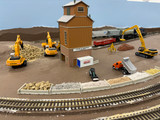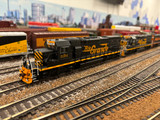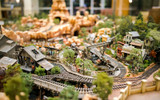Part 3: Converting the Track and Wiring for Model Train Layouts
Welcome back to our series on model train layouts! In Parts 1 and 2, we discussed the basics of designing and building your dream model train layout. Now, in Part 3, we'll delve into the crucial process of converting your track and wiring for Digital Command Control (DCC) operation. This transformative step will bring new life to your layout, allowing for greater control and realism. So, let's get started!
3.1 Removing Existing DC Wiring
Before you can begin converting your model train layout to DCC, it's essential to remove any existing DC (Direct Current) wiring. If your layout has been operating on DC power, you'll need to undo the old connections and prepare the track for the DCC system.
Here's how to remove existing DC wiring:
- Power Off: First, disconnect the power supply to your DC system and ensure that the layout is entirely de-energized.
- Remove Wiring: Carefully remove all the DC wires from the track and accessories. Label and organize them if you plan to reuse any for other purposes later.
- Unsolder Joints: If you've soldered any connections, desolder them using a soldering iron. Be cautious not to damage the track or components in the process.
- Clean the Track: After removing the wires, clean the track thoroughly to ensure good conductivity. Use track cleaning products, abrasive pads, or a track cleaning car to remove dirt, grime, and oxidation.
- Inspect and Repair: Inspect the track and any accessories for damage during the removal process. Repair or replace any broken or worn components.
3.2 Installing DCC-Friendly Track Components
Now that your track is free from the old DC wiring, it's time to prepare it for DCC operation. DCC systems rely on a continuous electrical connection to the track, so it's essential to make sure your track components are DCC-friendly.
Here's how to install DCC-friendly track components:
- Check Track Compatibility: Some older track systems may not be suitable for DCC operation due to poor electrical conductivity. Ensure that your track is compatible with DCC by consulting the manufacturer's guidelines or seeking advice from hobby shops or online forums.
- Upgrade to DCC-Ready Track: If necessary, consider upgrading your track to DCC-ready track sections. These tracks are designed with improved electrical connectivity, eliminating the need for track feeders and making DCC installation more straightforward.
- Install Insulating Joiners: For DCC, it's essential to isolate different track sections to prevent short circuits. Install insulating joiners or rail joiner isolators between sections of track that need to be electrically separate.
- Add Power Bus: To provide power to the entire layout consistently, set up a power bus that runs parallel to the track. This bus will distribute power from the DCC command station to various sections of your layout.
- Connect Feeders: Solder or attach track feeders from the power bus to the track sections. Ensure that you have consistent and secure connections to avoid power drop-offs or disruptions.
3.3 Wiring Your Layout for DCC Operation
With your track components prepared for DCC, it's time to wire your layout for DCC operation. DCC offers precise control over multiple trains, accessories, and lighting, making wiring a critical step.
Here's how to wire your layout for DCC operation:
- DCC Command Station: Begin by installing your DCC command station, which is the heart of your DCC system. Follow the manufacturer's instructions for connecting it to the power bus and programming track.
- Track Power Zones: Divide your layout into power zones, each independently controlled by the DCC system. Connect these zones to the command station using separate wires or track feeders. This allows you to control trains and accessories in different areas of your layout simultaneously.
- Accessory Decoders: If you have accessories like turnouts, signals, or lights, install accessory decoders to control them digitally. Connect these decoders to the command station and program their addresses to operate them using your DCC controller.
- Throttle and Handheld Controller: Set up your throttle and handheld controller, allowing you to control trains with precision. Ensure they are connected to the DCC system according to the manufacturer's instructions.
- Testing and Troubleshooting: Before finalizing your wiring, test each section of your layout to ensure that trains run smoothly, turnouts operate correctly, and accessories respond as expected. Troubleshoot any issues promptly.
- Label and Organize: Properly label all wires and connections to make future maintenance and troubleshooting easier. Keep a detailed record of your wiring layout for reference.
Converting your model train layout to DCC operation is a significant step toward achieving realistic and versatile train operations. While it may seem daunting, taking it one step at a time and consulting with experienced model railroaders or DCC experts can make the process smoother. Once your layout is DCC-ready, you'll have endless possibilities for train control and enjoyment, bringing your miniature world to life like never before. Stay tuned for our next installment in this series, where we'll explore advanced scenery and detailing techniques to complete your model train masterpiece. Happy railroading!
Recent Posts
-
All Aboard the Wisdom Express: Life Lessons from Model Railroading
Embarking on the journey of model railroading opens the door to a world where imagination meets prec
-
Capturing History in Miniature: The Art of Prototype Modeling in the Model Railroad World
Prototype modeling in the model railroad world involves creating miniature replicas of real-life tra
-
Unveiling the Imaginative World of Fictional Railroads: Where Creativity Meets the Rails
Model railroading has long been a hobby rooted in historical accuracy and meticulous attention to de




